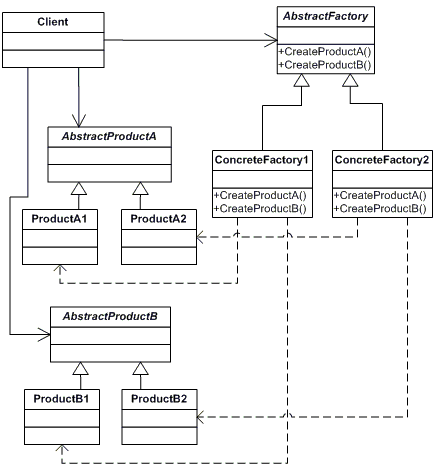| Abstract Factory |
Provide an interface for creating families of related or dependent objects without specifying their concrete classes.
Frequency of use:  medium high medium high
|
| UML class diagram |
 |
| Participants |
- AbstractFactory (ContinentFactory)
- declares an interface for operations that create abstract products
- ConcreteFactory (AfricaFactory, AmericaFactory)
- implements the operations to create concrete product objects
- AbstractProduct (Herbivore, Carnivore)
- declares an interface for a type of product object
- Product (Wildebeest, Lion, Bison, Wolf)
- defines a product object to be created by the corresponding concrete factory
- implements the AbstractProduct interface
- Client (AnimalWorld)
- uses interfaces declared by AbstractFactory and AbstractProduct classes
|
| Sample code |
This structural code demonstrates the Abstract Factory pattern creating parallel hierarchies of objects. Object creation has been abstracted and there is no need for hard-coded class names in the client code.
// Abstract Factory pattern -- Structural example
//--------------------------------------------------------
// Copyright (C) 2001 - 2002, Data & Object Factory
// All rights reserved. www.dofactory.com
//
// You are free to use this source code in your
// applications as long as the original copyright
// notice is included.
//
// THIS CODE AND INFORMATION IS PROVIDED "AS IS" WITHOUT
// WARRANTY OF ANY KIND, EITHER EXPRESSED OR IMPLIED,
// INCLUDING BUT NOT LIMITED TO THE IMPLIED WARRANTIES OF
// MERCHANTABILITY OR FITNESS FOR A PARTICULAR PURPOSE.
//--------------------------------------------------------
using System;
// "AbstractFactory"
abstract class AbstractFactory {
// Methods
abstract public AbstractProductA CreateProductA();
abstract public AbstractProductB CreateProductB();
}
// "ConcreteFactory1"
class ConcreteFactory1 : AbstractFactory {
// Methods
override public AbstractProductA CreateProductA() {
return new ProductA1();
}
override public AbstractProductB CreateProductB() {
return new ProductB1();
}
}
// "ConcreteFactory2"
class ConcreteFactory2 : AbstractFactory {
// Methods
override public AbstractProductA CreateProductA() {
return new ProductA2();
}
override public AbstractProductB CreateProductB() {
return new ProductB2();
}
}
// "AbstractProductA"
abstract class AbstractProductA {
}
// "AbstractProductB"
abstract class AbstractProductB {
// Methods
abstract public void Interact( AbstractProductA a );
}
// "ProductA1"
class ProductA1 : AbstractProductA {
}
// "ProductB1"
class ProductB1 : AbstractProductB {
// Methods
override public void Interact( AbstractProductA a ) {
Console.WriteLine( this + " interacts with " + a );
}
}
// "ProductA2"
class ProductA2 : AbstractProductA {
}
// "ProductB2"
class ProductB2 : AbstractProductB {
// Methods
override public void Interact( AbstractProductA a ) {
Console.WriteLine( this + " interacts with " + a );
}
}
// "Client" - the interaction environment of the products
class Environment {
// Fields
private AbstractProductA AbstractProductA;
private AbstractProductB AbstractProductB;
// Constructors
public Environment( AbstractFactory factory ) {
AbstractProductB = factory.CreateProductB();
AbstractProductA = factory.CreateProductA();
}
// Methods
public void Run() {
AbstractProductB.Interact( AbstractProductA );
}
}
/// <summary>
/// ClientApp test environment
/// </summary>
class ClientApp {
public static void Main(string[] args) {
AbstractFactory factory1 = new ConcreteFactory1();
Environment e1 = new Environment( factory1 );
e1.Run();
AbstractFactory factory2 = new ConcreteFactory2();
Environment e2 = new Environment( factory2 );
e2.Run();
Console.Read();
}
}
|
This real-world code demonstrates the creation of different animal worlds for a computer game using different factories. Although the animals created by the Continent factories are different, the interactions among the animals remain the same.
// Abstract Factory pattern -- Real World example
//--------------------------------------------------------
// Copyright (C) 2001 - 2002, Data & Object Factory
// All rights reserved. www.dofactory.com
//
// You are free to use this source code in your
// applications as long as the original copyright
// notice is included.
//
// THIS CODE AND INFORMATION IS PROVIDED "AS IS" WITHOUT
// WARRANTY OF ANY KIND, EITHER EXPRESSED OR IMPLIED,
// INCLUDING BUT NOT LIMITED TO THE IMPLIED WARRANTIES OF
// MERCHANTABILITY OR FITNESS FOR A PARTICULAR PURPOSE.
//--------------------------------------------------------
using System;
// "AbstractFactory"
abstract class ContinentFactory {
// Methods
abstract public Herbivore CreateHerbivore();
abstract public Carnivore CreateCarnivore();
}
// "ConcreteFactory1"
class AfricaFactory : ContinentFactory {
// Methods
override public Herbivore CreateHerbivore() {
return new Wildebeest();
}
override public Carnivore CreateCarnivore() {
return new Lion();
}
}
// "ConcreteFactory2"
class AmericaFactory : ContinentFactory {
// Methods
override public Herbivore CreateHerbivore() {
return new Bison();
}
override public Carnivore CreateCarnivore() {
return new Wolf();
}
}
// "AbstractProductA"
abstract class Herbivore {
}
// "AbstractProductB"
abstract class Carnivore {
// Methods
abstract public void Eat( Herbivore h );
}
// "ProductA1"
class Wildebeest : Herbivore {
}
// "ProductB1"
class Lion : Carnivore {
// Methods
override public void Eat( Herbivore h ) {
// eat wildebeest
Console.WriteLine( this + " eats " + h );
}
}
// "ProductA2"
class Bison : Herbivore {
}
// "ProductB2"
class Wolf : Carnivore {
// Methods
override public void Eat( Herbivore h ) {
// Eat bison
Console.WriteLine( this + " eats " + h );
}
}
// "Client"
class AnimalWorld {
// Fields
private Herbivore herbivore;
private Carnivore carnivore;
// Constructors
public AnimalWorld( ContinentFactory factory ) {
carnivore = factory.CreateCarnivore();
herbivore = factory.CreateHerbivore();
}
// Methods
public void RunFoodChain() {
carnivore.Eat( herbivore );
}
}
/// <summary>
/// GameApp test class
/// </summary>
class GameApp {
public static void Main( string[] args ) {
// Create and run the Africa animal world
ContinentFactory africa = new AfricaFactory();
AnimalWorld world = new AnimalWorld( africa );
world.RunFoodChain();
// Create and run the America animal world
ContinentFactory america = new AmericaFactory();
world = new AnimalWorld( america );
world.RunFoodChain();
Console.Read();
}
}
|